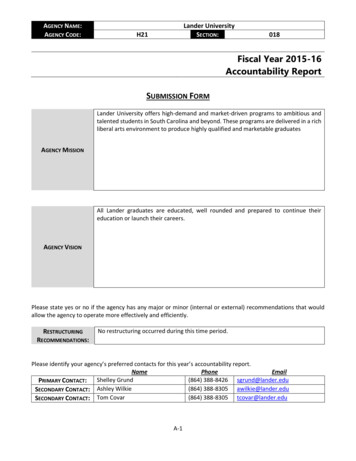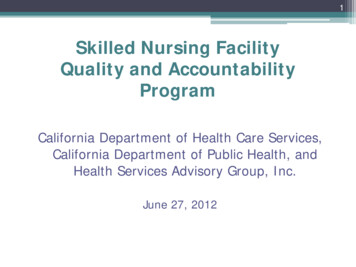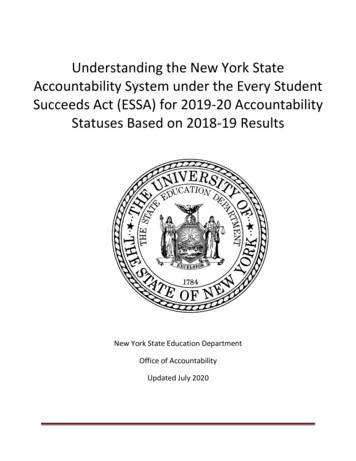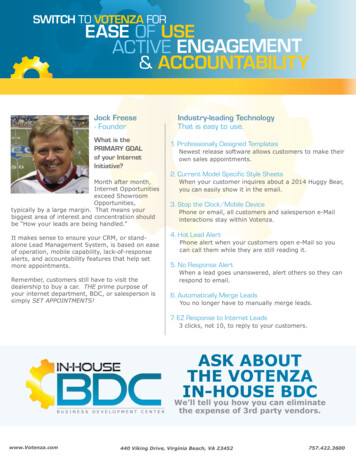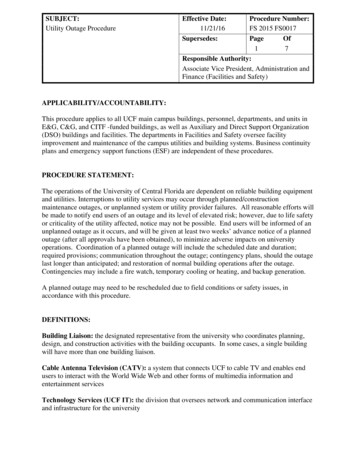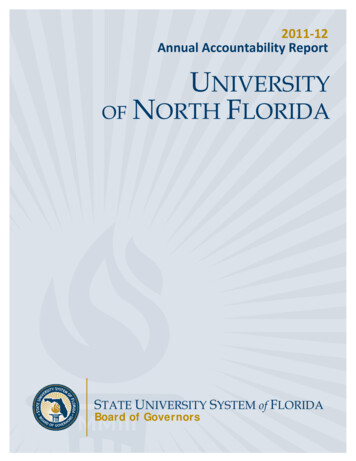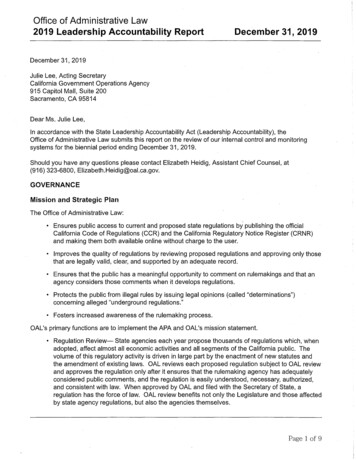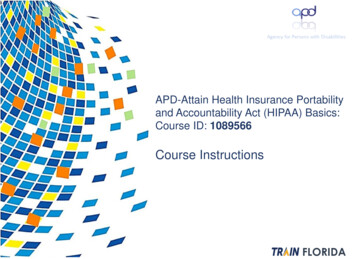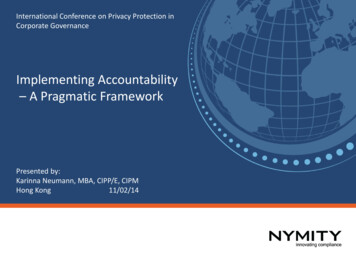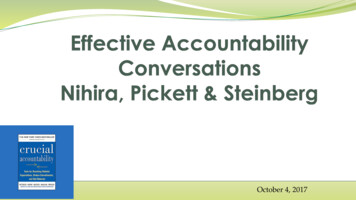
Transcription
October 4, 2017
Disclosures Nihira I have no relevant disclosures Pickett I have no relevant disclosures Steinberg I have no relevant disclosures
Learning ObjectivesFollowing this activity a learner will be able to:Recognize the elements of the Crucial AccountabilitymodelDescribe an expectation gapIdentify barriers that keep individuals from doingwhat is expectedCreate an accountability conversation planner to holdother accountable
AGENDA Introductions Review of worksheet concepts Nihira Questions 3 & 4 Pickett Questions 5 & 6 Steinberg Questions 7 & 8 Roleplay
Crucial Accountabilitybased on the book by:By Kerry Patterson, Joseph Grenny, Ron McMillan and Al SwitzlerMikio Nihira, MD, MPHClinical Professor of OB/GYNProgram Director UC Riverside OB/GYN Residency
NEW DEMANDS, INSUFFICIENT RESOURCES
Objectives Introduce tools to determining “What”. Discuss “What” scenarios in regard to your professional environment. Introduce tools to determine “If” accountability conversation shouldcommence.
What? & How?CPR Tool Ask yourself “What is the right problem?”ContentPatternRelationship Approach: Unbundle Isolate Target Be Concise
“What” DiscussionWas there an instance in which you chose the wrong “WHAT”?How could you have identified you were addressing the wrong problem?How could you apply CPR to redirect you accountability discussion?
Deciding “If”HoldAccountabilityConversation?Clearly aBrokenPromiseUnclear or“Iffy”
Unclear and “Iffy”Not Speaking when youShouldSpeaking when youShouldn’tActing out my concerns?Differentiate YourselfConscience Nagging Me?No “Nanner-Nanner”Choosing Certainty of Silence?Convinced I’m Helpless?
“If” DiscussionShare a situation in your professional environment where an expectationis clearly violated?Share a situation in your professional environment where an expectationwas violated, but you were “Iffy” whether to pursue an accountabilityconversation?
The Next Step“WHAT” & “IF” Established SuccessfullyNOW WHAT DO WE DO?
“Hazardous ½ Minute” Sets the Overall Tone of InteractionSee &HearTell aStoryFeelActCommon System Errors“Trail of Doom”Conclusions and AssumptionsSilenceViolence
“Hazardous ½ Minute”SOLUTIONSTell the rest of the StoryConsider 6 Sources ofInfluenceApply Sources ofInfluence
“Hazardous ½ Minute”MotivationAbilityPersonalWant ToCan DoSocialPeer PressureHelp from OthersStructuralCarrots & SticksStructures, Environments,& Tools
“Hazardous ½ Minute” DiscussionIs there a time where you lacked the ability tosee your role in the accountability problem?
Final Comments“The best leaders and parents aren’t lax with accountability, nor do theylet themselves stew in a stupor of self-loathing”“Step up and handle the promise when someone fails you”
Crucial Accountability What makes a conversation “crucial” vs. typical? First, opinions vary Second, the stakes are high Third, emotions run strong
Crucial Accountability How do we typically handle crucial conversations: We can avoid them We can face them and handle them poorly We can face them and handle them well
Crucial Accountability Why don’t crucial conversations tend to go well? Emotions tend to rule Your body physically reacts We are under pressure We are stumped We act in self defeating ways
Crucial Accountability “Common” Crucial Conversations Ending a relationship Asking a friend to repay a loan Giving the boss feedback about her behavior Critiquing a colleague’s work Talking to a team member who isn’t keeping commitments Talking to a colleague who is hoarding information or resources
Crucial Accountability Why it is important to master crucial conversation skills: Kick Start Your Career Improve Your Organization Improve Your Relationships Revitalize Your Community Improve Your Personal Health
Crucial Accountability There are 8 Principles and Skills See your chart in the handouts Review the Law of Crucial Conversations graphic
Get Unstuck Spot the conversations that are keeping you stuck Hold the right crucial conversation with CPR
Get UnstuckPartner Discussion: What conversations am I not holding or not holding well? Share an example of a conversation which is long overdue. Am I holding the right crucial conversations?
Start with Heart Work on me first Focus on what you really want Refuse the Sucker’s Choice
Start with HeartActivity: Watch Video Clip, “The aspx What do I really want? Am I behaving in ways that move me toward what I want? Am I making Sucker’s Choices?
Learn to Look Look for when a conversation becomes crucialLook for silence and violenceLearn to look for your own Style Under Stress Activity: Watch video clips/ labelhttps://www.vitalsmarts.com/skillsvideo.aspx
Learn to Look Am I noticing signs that safety is at risk? Am I moving to my Style Under Pressure?Activity: Take a few minutes to complete the survey independently.- The survey can be submitted/scoredon the VitalSmarts website.
Make It Safe Apologize when appropriate Contrast to fix misunderstandings Create Mutual Purpose
Make It Safe Have I established Mutual Purpose? Have I maintained respect? Activity: Watch video clip. Share an example of how we can “make itsafe” for our staff px
Master My Stories Separate facts from stories Watch for three clever stories Victim, Villain and Helpless Tell the rest of the story
Master My Stories Am I pretending not to notice my role in the problem? Why would a reasonable, rational, and decent person do this? What should I do right now to move toward what I really want?Activity: Watch video clip, how could this same example be appliedto a school px
STATE My Path STATE: Share your facts Tell your story Ask for others’ paths (what) Talk tentatively Encourage testing (how)
STATE My Path Am I really open to others’ views? Am I confidently expressing my own views?
Explore Others’ Paths Explore with added AMPPs: Ask Mirror Paraphrase Prime
Explore Others’ Paths Am I actively exploring others’ views?
Move to Action Decide how to decide Document who does what by when and follow-up
Move to Action What is the plan from here?
“Hazardous ½ Minute” DiscussionIs there a time where you lacked the ability tosee your role in the accountability problem?
Final Comments“The best leaders and parents aren’t lax with accountability, nor do theylet themselves stew in a stupor of self-loathing”“Step up and handle the promise when someone fails you”
Crucial Accountability “Common” Crucial Conversations Ending a relationship Asking a friend to repay a loan Giving the boss feedback about her behavior Critiquing a colleague’s work Talking to a team member who isn’t keeping commitments Talkin

